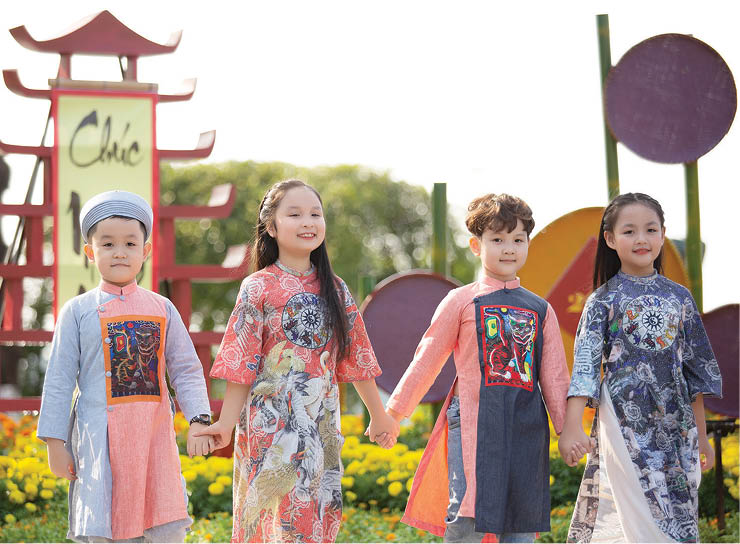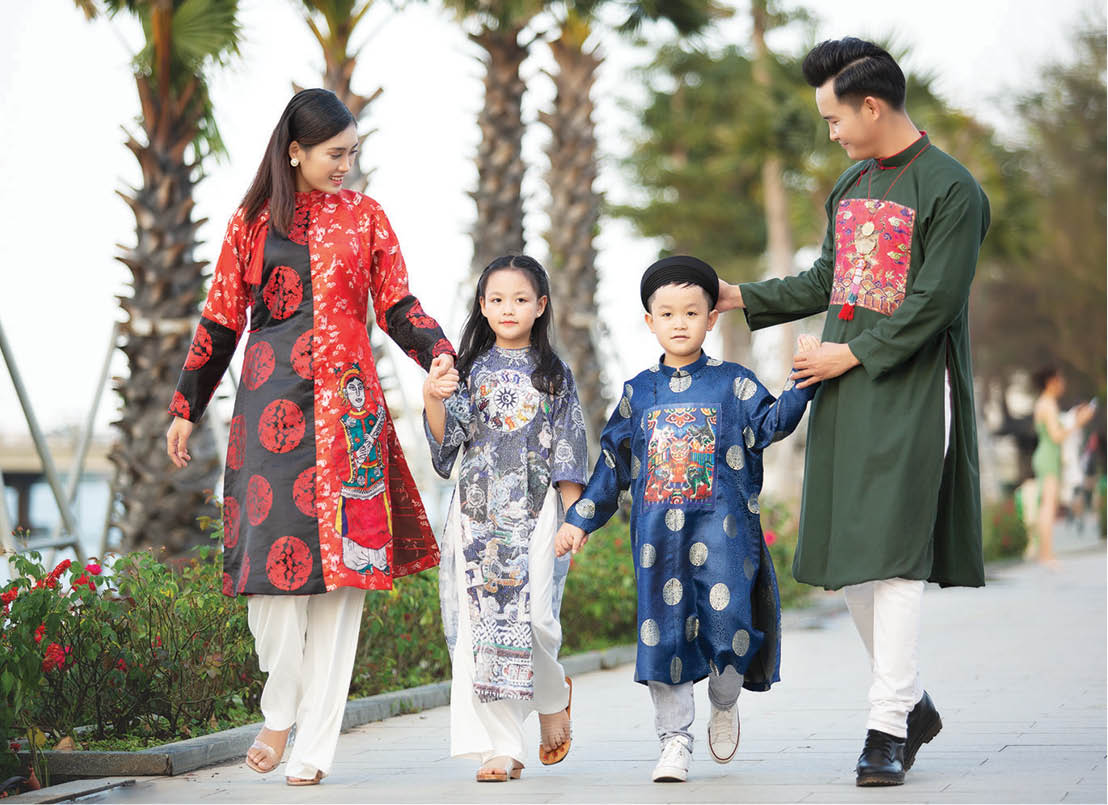
Designs inspired by folk paintings
In the New Year of the Tiger 2022, the designer Viet Bao introduced to the public the collection of "Tet paintings on Ao Dai Vietnam". Targeting Ao Dai designs for spring outings for the family, the collection included 30 designs of men's, women's, and children's Ao Dai. The designs are decorated with motifs from Hang Trong paintings, Dong Ho paintings, and Sinh village paintings, which are often used as Tet decorations.
The highlight was the image of the five tiger in Dong Ho and Hang Trong folk paintings printed on men's Ao Dai. With women's Ao Dai, Viet Bao used the image of the bat am (eight musical instruments) from Sinh village folk paintings to honor Hue’s court music, an intangible cultural heritage. The women's Ao Dai designs also harnessed the beauty of the color of the diep paper, exquisite and expressing bold cultural imprint.

Designs in the collection "Tet paintings on Ao Dai Vietnam"
The folklore imprints were selected, arranged harmoniously and delicately on the brocade, cotton, and linen fabrics. The beauty of folk paintings was showcased on Ao Dai, giving Ao Dai a striking feature.
Viet Bao shared: “I was inspired by the theme of Tet paintings to bring the breath of new spring to the traditional Ao Dai. Thereby, I hope to promote the beauty of folk paintings of Vietnamese craft villages. With Sinh village paintings, I incorporated the image of a circle of 12 zodiac animals from the engraving mold and the bat am motif with the image of girls holding musical instruments to honor Hue’s court music”.
Viet Bao’s Center for Hue Ao Dai is also the representative unit of Hue to participate in the Ao Dai Festival organized by the Department of Tourism, Ho Chi Minh City in March to honor the beauty of the traditional Ao Dai. Promoting Hue Ao Dai at this festival, Viet Bao introduced to the public nationwide the collection "Sediment of Hue poetry", including designs inspired by fine art motifs of the Nguyen Dynasty.

Transferring sketches onto Ao Dai
The Ao Dai designs were diverse, rich in colors and textures. These were decorated by Viet Bao following the art of embossed mosaics, lacquered inlays, mother-of-pearl inlays, painted enamels... on royal architectural works, creating a prominent feature in the Ao Dai design, an unmistakable Hue style.
Viet Bao also adapted many paintings by Hue painters; bringing the beauty of the mossy mausoleum and pagodas of Hue through the lines of sketch art on the Ao Dai. This was also how he promoted the beauty of his homeland's cultural heritage.
The motifs of royal fine art and sketches were selected by Viet Bao, designed per the decoration style of Ao Dai, then printed and dyed with digital technology. Thanks to this technology, paintings, sketches, and textures retain all their artistic value when they are transformed onto Ao Dai. In Hue, Viet Bao is one of the pioneers in applying this technique.
The designer Viet Bao said: “Hue Ao Dai is famous because of its skillful tailors, but the market for fabric materials in Hue is not rich. Therefore, I am intent on creating fabrics that are printed, dyed, and decorated with Hue colors. The Department of Industry and Trade has also facilitated the application of technological equipment for digital printing and dyeing.
In the course of Hue's ongoing effort to become "The Capital of Ao Dai Vietnam", the creation of collections with Hue's imprint is a one-of-a-kind idea for increasing the value and brand name of Hue Ao Dai. When visiting Hue, tourists can purchase Ao Dai made in Hue that not only is tailored by talented hands but also bears the designs inspired by cultural heritage and paintings, with motifs unique to the beautiful scenery of the land of the Huong River and Mount Ngu Binh.
Story: MINH HIEN - Photo: Provided by Viet Bao
